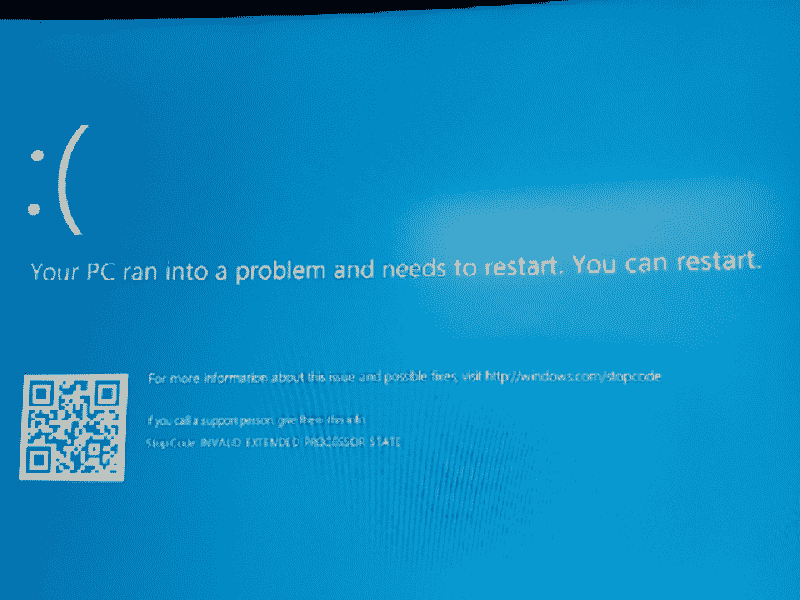Did you also face INVALID_EXTENDED_PROCESSOR_STATE Error in Windows 10 or 11? This issue having bug check value 0x00000131 makes the OS automatic restart continuously without any notable reason. Moreover, it also freezes the desktop, not allowing the users to access the device. Being originated from both software and hardware troubles, this Blue screen of death issue causes unparalleled damage to Windows.
INVALID_EXTENDED_PROCESSOR_STATE Error BSOD in Windows 11 or 10 mainly occurs because of outdated and poor-quality device drivers. Exploring the reasons, infection from malware, missing DLL files, deleted system components, badly allocated memory, and having similar programs in the system come forward. In addition, from the hardware side, piling up of unnecessary components jamming the Disk, running lack of space, bad sector present are responsible as well. You might see lots of weird warning texts once attempt to start a program or end it. Before this notorious bug takes control over the device fully, we need to step forward. Today we will discuss some amazing ways to resolve this error easily.
Table of Contents
INVALID_EXTENDED_PROCESSOR_STATE in Windows 10 and 11 Solutions
Here is how to fix INVALID_EXTENDED_PROCESSOR_STATE Error BSOD in Windows 10 or 11 –
Way-1: Block Automatic Restarting of Windows
The first thing we really need to do is to halt Windows 11 or 10 from rebooting as it is daunting the most. It won’t be surprising as this workaround will not heal but definitely make the proper way out for others to be executed. Here is how to block the Automatic Restarting –
- Move ahead to Desktop prior to saving any ongoing process by pressing Win+D together.
- When in the Desktop area, make a right-click on This PC icon from here and also choose Properties from the available menu.
- After the new System window is visible, do a click on “Advanced system settings” located in the left wing.
- Moving to the popup wizard of System Properties, enter into its Advanced tab.
- Here, move the pointer slightly down and do a click on Settings located in the Startup and Recovery region.
- A new wizard will unroll immediately and you need to reach the System failure area first.
- Once there, remove the checkmark from the box ahead of Automatically restart.
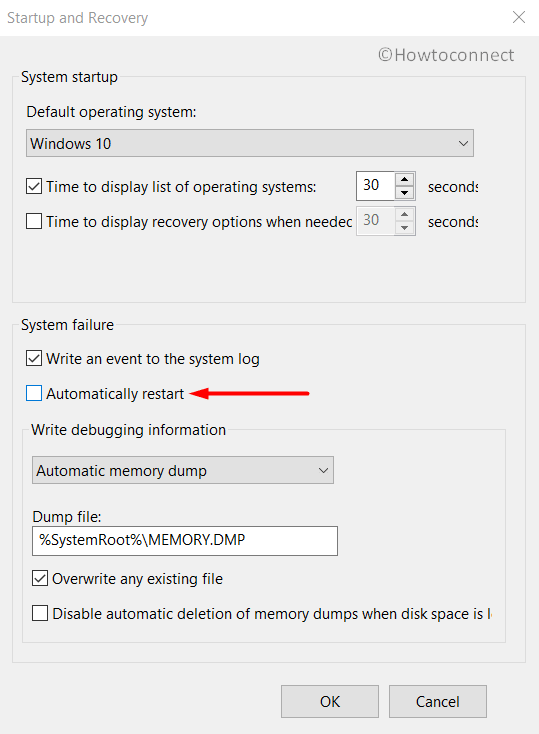
- Finally, perform a click on the Ok button from the bottom and leave the wizard later on.
Way-2: Make the Old drivers updated in Device Manager
In the Device Manager, the outdated drivers are indicated with Yellow indication mark. This will be easier to understand which is playing a big role in causing INVALID EXTENDED PROCESSOR STATE. We can expect that, after updating these, there will be no more issues. Give it a try following the below steps-
- Right click on Start.
- Once the Win+X menu appears, select Run.
- In the text box given here, type devmgmt.msc and hit Enter key.
- Device Manager will be opened immediately and just have a close look for an exclamation mark in the console.
- If have any, select that very device and expand it in the process.
- Now, right-click on the problematic driver and select the option namely Update driver.
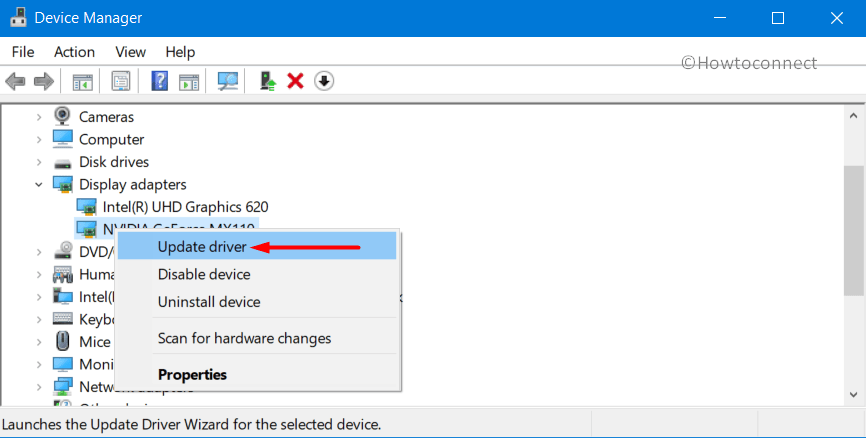
- The next movement will be in accordance with visible instructions provided by the system itself.
- Do all these and update these drivers eventually to get rid of INVALID_EXTENDED_PROCESSOR_STATE Error BSOD.
Way-3: Perform Installation of All the Available Update Patches
Major patches including cumulative updates are full packages with the latest features and fixes for various bugs and problems. If you keep these pending, will definitely miss out many things. An outdated Windows OS is slightly weaker and prone to allow BSOD bugs inside. Therefore, now we will install these patches in the following method. However, kindly ensure you have connected the device with a good internet connection such as “Ethernet or Wi-Fi”. You can also try from Mobile data but need to disable the “Metered connection” first. Here is the instruction to follow-
- Press the Windows key and upon spreading the Start menu, select the Gear icon.
- On the Windows Settings app, click on Update & Security.
- When the next page comes into the view, choose Windows Update and sharply jump alongside.
- If you come across a “You’re up to date” dialog here, don’t bother and click on Check for updates available under it.
- Cumulative patches upon searching will be visible here having a Download button at the end.
- Hit this Download and let Windows initiate the process.
- After finishing up the downloading, the installation will begin automatically.
- If the Windows prompts for restarting, co-operate with the process.
After the Operating System is up to date, there might not be any issues further.
Way-4: Make a habit of Regular Malware Scanning in Windows Security
Nowadays, you cannot really trustfully on the web as there might always be a virus or malware attack. When these bugs get a chance to enter the system, they play with system elements. In the process, some of the very important things get removed and the device run in INVALID_EXTENDED_PROCESSOR_STATE Error BSOD. We can make a habit of checking and removing these viruses in Windows Security app to avoid deadly sequences. See the process below-
- Press Windows and S keys together and open up the Taskbar Search.
- In the box available for typing, write security here.
- After Windows Security reached in result, select it to open the application.
- Select the Virus & threat protection section seen in the left pane.
- Jumping on the corresponding side, make a click on the Scan options link first.
- Now, select the Full scan and then Scan now to initiate the process.

- Windows Security upon finishing the malware detection will show the report on display. If any issue is present there, hit the Clean threats button to dismiss them.
- Proceeding to the next page, click on Remove and then Start actions to completely dismiss the threats.
Way-5: Make the Proper use of Windows Blue Screen Troubleshooter
Windows 10 and 11 are by far the most successful Operating System that Microsoft has brought in front. To make it more categorized, Windows Blue Screen Troubleshooter is included to fight BSOD issues. This is in the shape of a walkthrough guide on an official Microsoft page. Here is how to use the utility-
- Go to the troubleshooter page.
- .Select the option that matches your need from – Step 1: When did you get the error? – 1. After an update was installed 2. While using my device.
- Carefully go with the guidelines provided under Step 2 on the page.
This utility upon activation will easily fix BSOD issues present in the system automatically and you can have an error-free device afterward.
Way-6: Perform the Basic Treatment for all problems- Boot in Safe Mode
Starting from the ancient Windows days till today, booting in Safe Mode comes up strong to fight against all critical issues. BSOD error growing fast and causing huge damages hence, we can try this primitive resolution process. The Steps are as follows-
- Open the Run dialog box by pressing “Win+R” hotkeys together.
- Upon the arrival of the Run dialog, type msconfig in the text box available here.
- Once you hit Enter key, the System Configuration window will be visible on display.
- Shift to its Boot tab and reach the second half in the window read as Boot options.
- Check Safe Boot which will eventually activate all the grayed-out options here.
- Choose the radio button before Minimal and continue to move downward.
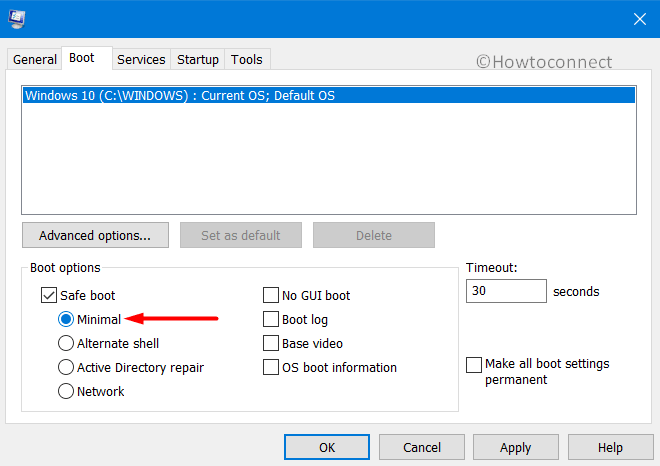
- Click the Apply button first and then OK to save these changes for the next task.
- Select Restart on the warning pop-up.
- If you are trying to return to a normal desktop follow this method – How to Come Out of Safe Mode in Windows 10.
Way-7: Uninstall is the only Barrier between similar apps to block staying over
Two or more similar types of programs when in conflict with each other force a few necessary OS elements to drive away. To stop this harmful act, removing one is the key. We can uninstall an app very easily using the below guidelines.
- Open the Run dialog (Windows+R).
- In the text box provided, type appwiz.cpl and click OK.
- Programs and Features window will sharply be seen on the screen and you can see all the installed apps listed here.
- Reach out to the programs colliding and causing INVALID_EXTENDED_PROCESSOR_STATE Error BSOD and select each.
- Choose the Uninstall option available in the upper ribbon to start the removal.
- If UAC prompts for approval, give consent by clicking Yes.
- When these programs are uninstalled completely, restart Windows to save them in the registry.
- Upon returning to Desktop afterward, check if there are any issues present.
- If the error resolves successfully, install the app again if you feel necessary.
Way-8: Use DISM Tool- the one-shot solution for defective Windows Image Files
Deployment Image Servicing and Management tool works handily in case of dreadful Windows image files causing INVALID EXTENDED PROCESSOR STATE Error BSOD. Therefore, we can execute it immediately in the elevated Command Prompt. See the method down below-
- Open the Taskbar Search by pressing Win+S.
- Type cmd.exe in the empty text area.
- Rright click on Command Prompt shown under Best matches.
- Eventually, choose Run as Administrator and after UAC prompts, hit Yes to provide consent.
- In the Black Elevated Prompt window, type the following command and hit the Enter key.
DISM.exe /Online /Cleanup-image /Restorehealth
In a moment the tool will start checking for problematic Windows image files and also fix them automatically. You might get rid of the INVALID_EXTENDED_PROCESSOR_STATE Error BSOD in Windows 11 or 10.
Way-9: Never Spare Memory issues and RAM problems unattended, fix them by using Windows Memory Diagnostic
In the dreadful segment in Random Access Memory, the wrong allocation will cause lots of issues including BSOD errors. Windows has its own memory diagnostic tool to help the user in this regard. Launch this utility using the below guidelines and fix these problems.
- Open the Windows Settings app by pressing Win+I hotkeys.
- In the app area, there is a text box for searching provided and you need to type memory here.
- After “Diagnose your computer’s memory problems” appears in a drop-down, select it.
- Windows Memory Diagnostic is once opened, select “Restart now and check for problems (recommended)”.

- Windows will straightway complete the first cycle of rebooting process with the command.
- When heading back to the desktop, you will come across a blue screen detecting memory problems.
- The progress rate will be shown in percentage and after it reaches 100%, Windows will restart for the second time.
- After the cycle is completed, you can find the report of the diagnosis in the Notification area located in System Tray.
After all the memory issues are resolved, we can expect there will be no INVALID EXTENDED PROCESSOR STATE BSOD error in your system.
Way-10: Run System File Checker to fix INVALID_EXTENDED_PROCESSOR_STATE
Sfc /scannow command line converted into System File Checker on Elevated Prompt serves the best and easy in fixing corrupted system components. It also recovers DLL files missing from Windows in the process, and can heal INVALID_EXTENDED_PROCESSOR_STATE Error BSOD quickly. To proceed with the resolution, follow the below steps-
- Right-click on the taskbar.
- After the menu shows up, select Task Manager and allow it to open.
- Select File from the left top corner and choose Run new task option.
- Once a dialog comes in the view, type cmd in the empty text space and also check the box before the option saying “Create this task with administrative privileges”.
- After you hit the Enter key, will be directly guided to Elevated Command Prompt.
- In the black window, type the following command where a cursor blinks –
Sfc /scannow
When you hit the “Enter” key, the System File Checker will be activated and detect all the corruptions in system components. Detected issues will be resolved automatically as well. In the process, you can also get rid of INVALID EXTENDED PROCESSOR STATE Error BSOD in Windows 10 or 11.
Way-11: Bade Farewell to Free Third-Party Anti-virus solution
This is impractical to use a third-party anti-malware program while you have the default Windows Security. This will have no use and furthermore, using some can bring INVALID_EXTENDED_PROCESSOR_STATE Error BSOD as well. Hence, remove these from the system by following these instructions.
- Right click on Start.
- Select Settings.
- Click Apps and unveil its additional setting page.
- Select Apps & features located at the left pane and straightway jump to the corresponding side.
- On the right, after all the apps loaded successfully, reach out to the third-party anti-virus program.
- Select it and afterward, hit Uninstall from the elongated pane.
- Once User Account Control Asks for approval, select Yes to proceed.
- Perform the next move as shown on display until it is removed completely.
Way-12: Use System Restore to solve INVALID_EXTENDED_PROCESSOR_STATE
Changes done on Windows by installing an app or uninstalling something will cause the registry to tweak. If anything goes, either way, this will also cause INVALID_EXTENDED_PROCESSOR_STATE Error BSOD. So, if that happens in your device, can jump back to the earlier state performing the System Restore. Guidelines are as follows-
- Open the Taskbar Search and type rstrui in the empty space.
- Press Enter.
- Hit Next from wizard to proceed ahead.
- On the consequent screen, choose Show more restore points and reveal all the past created ones together.
- Select the latest one in the list and again hit Next to proceed.
- After the following screen comes ahead, click on Finish and initiate restoring.
Way-13: Drive away the problematic Windows Update
Windows Updating process is done through the Settings app and is an autonomous task. There should not be a disruption in the process but when happens, can call INVALID_EXTENDED_PROCESSOR_STATE Error BSOD. In such cases, we have to throw these files away immediately before they cause harm. You can easily remove them following the below steps –
- Press Windows and I simultaneously.
- Click on Update & Security.
- Shifting ahead to the following window, select the Windows Update from the left side and jump to the sideward pane.
- Here, click on View update history link and unroll all the past update patches.
- Now select Uninstall updates.
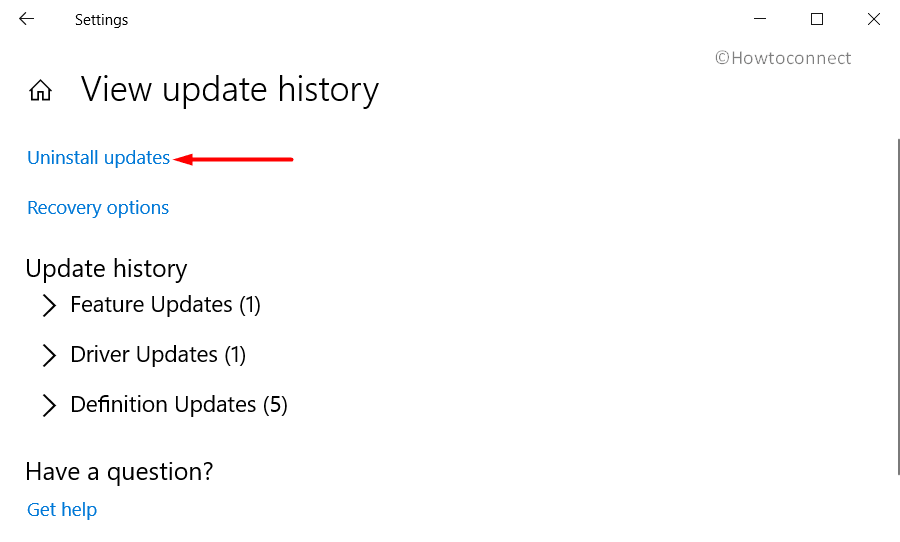
- By default, you will be directed to the Installed Updates page from Control Panel.
- Here, reach out to the recently received patch in the list and right-click on the same.
- Choose Uninstall option and follow the on-screen dialogs until these get removed properly.
Way-14: Let the Disk Cleanup Utility offer you more Space
If you are running in low disk space, this deteriorates the functionality of the device is cause INVALID_EXTENDED_PROCESSOR_STATE Error BSOD to occur. Disk Cleanup Utility can free up junk accumulated in the system and some of the spaces can be retrieved. You can go through the below process and free up space.
- Right click on the Start and select Run to launch the dialog.
- Type cleanmgr in the empty search box and eventually press Enter.
- Immediately a small popup will flash up asking to select the desired drive to perform freeing up.
- Select C: from the dropdown menu and press ‘Enter’.
- Disk Cleanup will show up after calculating the space it can retrieve and be visible in the wizard.
- Come down a little and click on Clean up system files from here. Again a small dialog will reappear and ask for choosing a preferable drive. Choose C: again in the same way before and hit Enter.
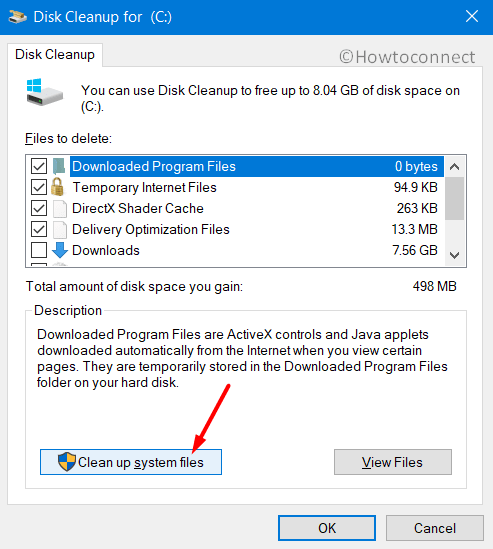
- Disk Cleanup for C: will be available on screen after calculation of retrievable space in system files.
- Reach to Files to delete segment and tick all the checkboxes.
- Press Win+D and head to Desktop now. Open the Recycle Bin and see if there are any important items here. If positive, restore them to their respective locations.
- Moving ahead to the Disk Cleanup wizard again, click Ok from the bottom and initiate cleaning.
This process might take a few minutes, don’t cancel it and let it end normally. After the process ends, Restart the device and when signing back next, see if the error exists.
Way-15: Execute Disc Checking Utility in Elevated Command Prompt and fix bad areas on Hard Disk
If there are any bad areas present on the Hard Disk, malfunctions will be there always. In worst cases, it might cause INVALID_EXTENDED_PROCESSOR_STATE Error BSOD also. Disk Checking Utility can fix it in the shortest possible time. Follow the below instruction to fix these areas–
- Get access to the Elevated Command Prompt using any of the above guidelines.
- Type in or copy-paste the below-mentioned syntax at the base of the winking cursor and hit the Enter key.
chkdsk C: /f /r /x
- Disk Checking Utility will immediately rise up and fix the poor areas in the Hard Disk volume. Here, we have used a few more notations for different purposes like –
C: – Drive we have installed the Windows. You can change it to E:. F: or any as per you have used.
f – forces the utility to fix the detected issues in the volume.
r – brings ahead the problematic areas present in the volume.
x – splits up the Disk Volume before the process begins.
This is a long process and might take several minutes to complete. Once done, Restart the device, and after that head back to operation, later on, check for the error in the system.
Way-16: Disconnect the Additional Hard Drive and give a break before reconnecting
Nowadays, we usually need an additional Hard Drive to store more files, study materials, and entertainment elements. Some people discovered this BSOD error in the system after they have used an extra HDD. The solution is pretty simple, just disconnect temporarily and reconnect them using the below guidelines.
- First things first, detach all the connected Hardware Accessories including the additional Hard drive from the computer.
- Reboot the device and once come back in operation, do a thorough check for the error in the system. If nothing shows up, you can be sure that there is no more BSOD error here.
- Start connecting the disconnecting accessories one after another.
- When finished, launch the default web browser and do a visit to the Manufacturer’s website for each respective item.
- Download and install the latest drivers to the system in the process.
So far we have discussed the workarounds to resolve INVALID_EXTENDED_PROCESSOR_STATE Error BSOD in Windows 10 and 11. It’s expected that the error is disappeared by now if you have correctly done all these methods. If the error still exists, don’t lose hope. We can have one more chance to resolve this annoying issue forever. As a definite hope, Clean Reinstallation to Windows comes at the top though it is a little hectic and professional task.
Once you have come to a decision to perform “Reinstallation of Windows 10”, save a backup for all the necessary files in a folder and take it out in USB. If you are not well competent to do this task, seek help from skilled ones. Hopefully, if everything is done with the utmost care, there will be no more errors and issues in the device afterward.
Methods:
Way1: Block Automatic Restarting of Windows
Way-2: Make the Old drivers updated in Device Manager
Way-3: Perform Installation of All the Available Update Patches
Way-4: Make a habit of Regular Malware Scanning in Windows Security
Way-5: Make the Proper use of Windows Blue Screen Troubleshooter
Way-6: Boot in Safe Mode
Way-7: Uninstall is the only Barrier between similar apps
Way-8: Use DISM Tool
Way-9: Never Spare Memory issues
Way-10: Run System File Checker
Way-11: Bade Farewell to Free Third-Party Anti-virus solution
Way-12: Use System Restore
Way-13: Drive away the problematic Windows Update
Way-14: Let the Disk Cleanup Utility offer you more Space
Way-15: Execute Disc Checking Utility
Way-16: Disconnect the Additional Hard Drive
That’s all!!
